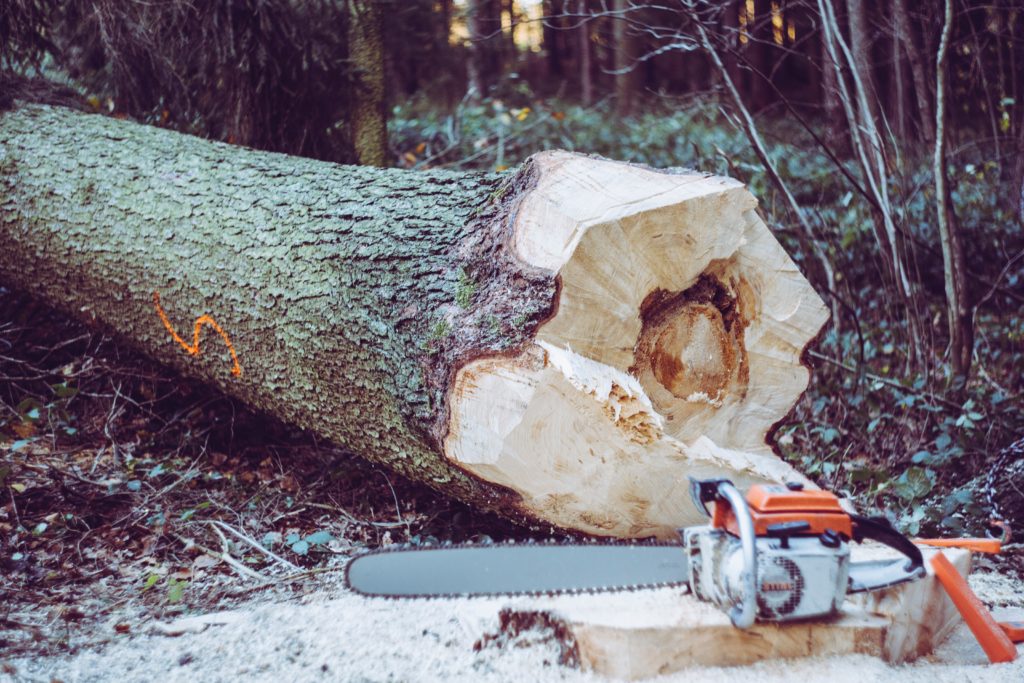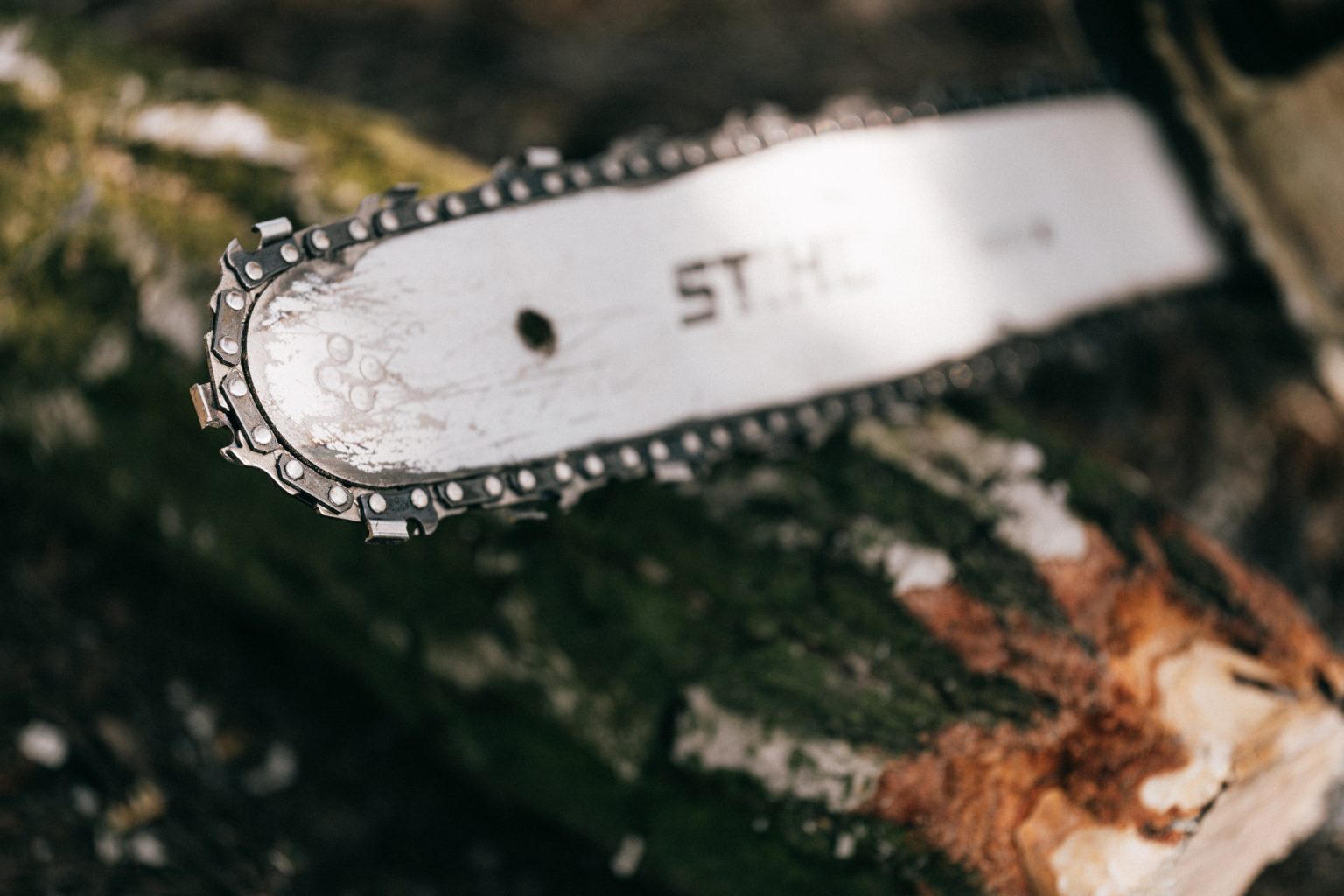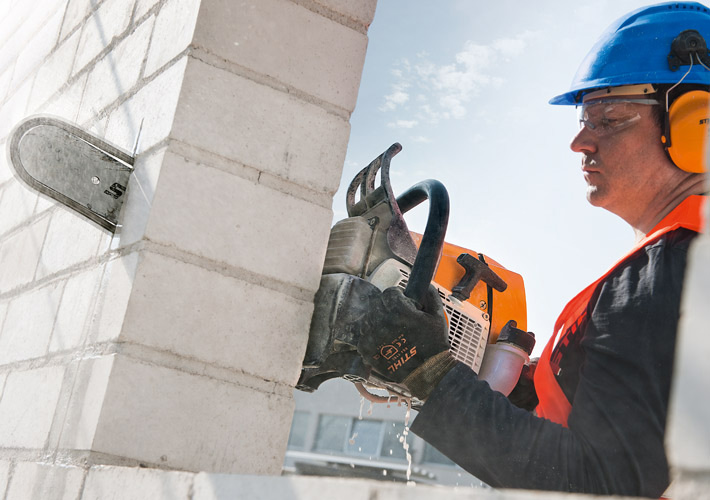As a general consumer, the options can be overwhelming when you are looking to purchase your first chainsaw. You may wonder how chainsaw ripping chains differ from standard chains, crosscut chains, and debarking chains. This comprehensive guide will help you understand the different types of chainsaw chains available and whether these chains are interchangeable. You’ll also learn why you need a ripping chain and how to measure your chainsaw to ensure you purchase the right chain.
Differences Between Full Chisel Chains, Semi-Chisel Chains, and Micro-Chisel Chains
The chain is the sharp, metal part of the chainsaw that does the cutting. It consists of a series of interconnected metal links, and each link has two main features: the cutter (also known as a tooth) and the drive link. The cutters do the actual work of cutting through wood. Chainsaw chains are available in three configurations: full, semi-chisel, and micro-chisel.
- A full chisel chain has teeth of the same size and shape. The teeth are very sharp, but they are also fragile and can be easily damaged. They are designed for general cutting and work well on softwoods and hardwoods.
- A semi-chisel chain has teeth that are a mix of two different sizes and shapes. The large teeth are for cutting, while the smaller teeth are for stability. These chains are less likely to damage the wood you are cutting, but they are also not as sharp as full chisel chains. They are better for more difficult cutting applications, such as green or dirty wood.
- A micro-chisel chain has teeth that are all the same size, but the shape of the teeth are different. The teeth are sharp and very strong and can withstand a lot of wear and tear. They are also better for heavy-duty cutting applications.
Types of Specialized Chainsaw Chains
Chainsaws are one of the most versatile and useful tools a homeowner can own. They can be used for various tasks, from cutting firewood to clearing brush. However, not all chainsaws are created equal. If you’re using your chainsaw for heavy-duty work, you’ll need to ensure that you have the right chain. The following covers the most common chainsaw chain types.
Standard Chains
Standard chainsaw chains are designed to fit a range of different saws. They come in various sizes, with the most common being 14″, 16″, 18″, 20″, and 22″. The chain contains a series of metal links that are connected by rivets.
- Without Guide Bar and Chain. Starter/Crankcase/Sprocket Cover as shown in the picture, make your work easier and safer.
- Type: G660 Power head. Displacement: 92CC / Power: 5.2KW
- It is with normal handle bar
- Guide Bar Type: Sprocket nose Chain Type: 3/8" , .063" Chain Sprocket: Standard 7 tooth 3/8" pitch
Ripping Chains
Chainsaw ripping chains have special teeth designed for cutting in the same direction as the wood grain. This type of chain is usually found on larger chainsaws for felling trees or cutting large logs. The teeth on the ripping chain are much larger and more widely spaced than those on other types of chains. This feature allows the chain to cut through wood more easily, but it is more likely to get stuck in the wood if the saw is not used correctly. When using a chainsaw with a ripping chain, it is important to keep the saw moving in a straight line and avoid turning it too sharply, which can cause the chain to get caught in the wood.
- 【Specifications】 24-inch ripping chain (84 drive links, 3/8" pitch, .050" gauge) for efficient tree felling and fast wood processing.
- 【Durable & Safe Design】 Hardened chrome outer layer and rivets reduce wear and minimize chain adjustments, with high-quality protection against corrosion
- 【Ripping-Optimized Chain】 This milling chainsaw chain leaves a cleaner cut and smoother finish than standard chains, though slower, making it ideal for milling and smooth wood surfaces.
- 【Fits】 Fits Husqvarna 455 Rancher 450 460. Replacement for Husqvarna 455 Rancher chain. Replacement for Husqvarna 450 460 chainsaw chain.
- 【Maintenance】 The built-in Lubri-Tec auto-oiling system delivers oil to critical chain components, reducing wear and maintenance while extending chain life and ensuring optimal cutting performance.
Cross-cut Chains

Cross-cut chains are made for cutting across the grain of the wood. This type of chain is most commonly used on smaller chainsaws, such as those used for pruning trees or cutting firewood. Cross-cut chains have smaller and more closely spaced teeth than other chains. It makes them less likely to get stuck in the wood, but it also makes them less effective at cutting through larger pieces of wood. Cross-cut chains are less likely to cause kickback than other chains, so they are a good choice for beginners or those not experienced in using chainsaws.
- Made In Sweden Pre-Stretched with 10% more cutting efficiency
- Part # 585550084
- Replaces H46 and H47
- 24" 3/8" .050" 84 Drive Link
Chainsaw Debarker Chains
Debarker chains are designed for removing the bark from trees. This type of chain is usually found on larger chainsaws for felling trees or cutting large logs. Debarker chains have special teeth that are curved and serrated. These teeth grip the bark and pull it off the tree as the chain moves around the tree’s circumference. Debarker chains can be dangerous if not used properly, so it is important to read the instructions carefully before using this type of chainsaw.
Ripping Chain vs. Standard Chain
Ripping chains specialize in cutting through hard, dense wood material. The teeth on this type of chain are spaced further apart, which allows it to slice through wood more easily. However, this also means that the ripping chain is not as effective at making smooth cuts. If you need to cut through a lot of tough wood quickly, a ripping chain is the way to go.
On the other hand, the standard chain makes smoother, more precise cuts. The teeth on this type of chain are closer together, which gives it more cutting power. However, this also means that standard chains can struggle with harder woods. A standard chain is the way to go if you need to make clean cuts that don’t require much effort. Also, standard chainsaws are less likely to get stuck in the wood but are also less effective at cutting through larger pieces of wood.
Ripping Chains vs. Cross-cut Chain
As the name suggests, a ripping chain is designed for making quick, clean cuts through the timber. The teeth on a ripping chain are narrower and more pointed than those on a cross-cut chain. They are also arranged in a staggered pattern to enable the chain to bite into the wood more effectively, resulting in a cleaner, faster cut.
In contrast, cross-cut chains produce different types of chainsaw cuts than ripping chains. Instead of cutting along the grain, a cross-cut chain cuts across the grain. The teeth on a cross-cut chain are blunter and more widely spaced than those on a ripping chain and are arranged in a straight pattern to make a smoother cut through the wood, but it also means that the cut will be slower and less precise.
Standard Chain vs. Cross-cut Chain
A standard chain is the more common type of chain, and it is typically less expensive than a cross-cut chain. It is also easier to sharpen, which can be a significant advantage if you do a lot of cutting. However, it is not as effective at cutting through tough materials like concrete or metal, and it can also cause more kickback than a cross-cut chain.
Cross-cut chains are less common than standard chains, but they are often considered superior for certain applications. A cross-cut chain cuts through tough materials more easily, making it an ideal choice for concrete or metal cutting. A cross-cut chain also causes less kickback than a standard chain. The downside of a cross-cut chain is that it is more expensive than a standard chain.
Why Would You Want a Ripping Chain?
There are a few reasons why you might want to consider a chainsaw ripping chain. First, it can help you quickly and easily remove trees in your way. A ripping chain is a good choice if you want a way to clear your landscape and do not need to worry about making precise cuts.
A ripping chain can be the right tool if you need to cut through tough, dense wood quickly. If you are cutting up dense firewood or large tree limbs, then a ripping chain can quickly work the task. At the same time, a ripping chain can be a lifesaver as it can be used to create firebreaks in the event of a wildfire.
Additionally, a ripping chain can be a good choice if you are looking for a chain that will stay sharp for a long time. A ripping chain is more resistant to wear and tear, which means it will stay sharp longer than other chain types. This can be a significant advantage if you do a lot of cutting or need to cut through tough materials regularly.
Can You Make Other Types of Chainsaw Cuts With a Ripping Chain?
Yes, you can use a chainsaw ripping chain to make other cuts, but it is not the ideal choice for all applications. A ripping chain is designed for making quick, rough cuts through tough materials. If you try to cross-cut with a ripping chain, you may experience erratic blade movement and more kickback. The cuts also will not be as clean or precise as they would be with a cross-cut chain. Additionally, if you are cutting through softer woods, a ripping chain can cause more damage to the wood than a standard chain.
Is a Ripping Chain Compatible for All Chainsaws?
A ripping chain is not compatible with all chainsaws as it is a specialized chain. Because its purpose is to cut through dense wood at a quick speed, you will need a chainsaw with more horsepower to use this chain. In general, you’ll be more likely to use a ripping chain on a gas chainsaw over an electric chainsaw because they have more horsepower and contain a body that better accommodates larger chains. Additionally, the bar and sprocket on your chainsaw must be specifically designed to work with a ripping chain.
How to Find the Measurement of Your Chainsaw?
The measurement of your chainsaw is extremely important as it will determine what size chain you need. The most common measurements for chainsaws are 18″, 20″, and 22″. However, there are other sizes available as well. If your chainsaw is new, you can easily find the information printed near the saw bar and other specifications related to chain replacement. You may also want to consult your user manual for the information.
What Is the Bar of Your Chainsaw?
The bar of your chainsaw is the metal piece that extends from the chainsaw body. It is the part of the chainsaw you hold on to when using it. The chain wraps around the bar and does the cutting.
What Is Bar Length?
Bar length is simply the measurement of the bar on your chainsaw. If you want to measure the bar length yourself, measure the length from the base of the chainsaw body to the tip of your chainsaw. You can round up to the nearest inch if the measurement is not a complete whole number.
What Is a Saw’s Gauge?
The saw’s gauge is the width of the chain. You can find this information printed on your chainsaw bar or in your user manual. The most common gauges for chainsaws are 0.058″, 0.05″, and 0.063″. You can also quickly find out the measurement by using a coin comparison. A 0.058″ gauge will roughly equal the thickness of a penny, 0.05″ the thickness of a dime, and 0.063″ the thickness of a quarter.
Material Options Available for a Ripping Chain
Chainsaw chains usually have three material options: carbide, chrome, and diamond. You’ll want to choose a chain made of carbide or diamond for ripping chains. Carbide is the most common and affordable material used for chainsaw chains. It is also the most durable option, making it ideal for a ripping chain. However, if you are looking for the absolute best cutting power possible, you may want to consider a diamond chain. Although they are more expensive, they will provide you with the best results.
Diamond Chainsaw Blades: What They’re for and Why They’re Used
If you’re in the market for a chainsaw chain, you must know what type of chain you need. A ripping chain is specialized for making quick, rough cuts through tough materials. Remember that the ripping chain is not compatible with all chainsaws and that you’ll need a chainsaw with more horsepower to use this chain. Additionally, the bar and sprocket on your chainsaw must be specifically designed to work with a ripping chain. To find out the measurement of your chainsaw, measure the bar length and the saw’s gauge. Ripping chains are usually made of carbide or diamond and provide you with the best results. When choosing a chain, keep this information in mind to make the best decision for your needs.




